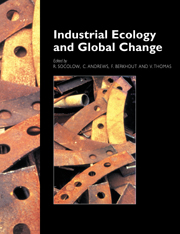Book contents
- Frontmatter
- Contents
- Foreword
- Preface
- Acknowledgments
- Contributors
- OVERVIEW
- PART 1 VULNERABILITY AND ADAPTATION
- PART 2 THE GRAND CYCLES: DISRUPTION AND REPAIR
- PART 3 TOXICS AND THE ENVIRONMENT
- 15 Introduction
- 16 Soil as a Vulnerable Environmental System
- 17 The Vulnerability of Biotic Diversity
- 18 Global Ecotoxicology: Management and Science
- 19 Industrial Activity and Metals Emissions
- 20 Metals Loading of the Environment: Cadmium in the Rhine Basin
- 21 Emissions and Exposure to Metals: Cadmium and Lead
- 22 Nuclear Power: An Industrial Ecology that Failed?
- PART 4 INDUSTRIAL ECOLOGY IN FIRMS
- PART 5 INDUSTRIAL ECOLOGY IN POLICY-MAKING
- END PIECE
- Organizing Committee Members
- Working Groups
- Index
21 - Emissions and Exposure to Metals: Cadmium and Lead
Published online by Cambridge University Press: 04 August 2010
- Frontmatter
- Contents
- Foreword
- Preface
- Acknowledgments
- Contributors
- OVERVIEW
- PART 1 VULNERABILITY AND ADAPTATION
- PART 2 THE GRAND CYCLES: DISRUPTION AND REPAIR
- PART 3 TOXICS AND THE ENVIRONMENT
- 15 Introduction
- 16 Soil as a Vulnerable Environmental System
- 17 The Vulnerability of Biotic Diversity
- 18 Global Ecotoxicology: Management and Science
- 19 Industrial Activity and Metals Emissions
- 20 Metals Loading of the Environment: Cadmium in the Rhine Basin
- 21 Emissions and Exposure to Metals: Cadmium and Lead
- 22 Nuclear Power: An Industrial Ecology that Failed?
- PART 4 INDUSTRIAL ECOLOGY IN FIRMS
- PART 5 INDUSTRIAL ECOLOGY IN POLICY-MAKING
- END PIECE
- Organizing Committee Members
- Working Groups
- Index
Summary
Abstract
Cadmium and lead are examined in terms of their damage to ecosystems and human health, and in terms of their uses and environmental emissions. In both cases, the major uses of the metals have only a small known effect on ecosystems or human health. For cadmium, non-occupational human health and ecosystem damage has been found only in areas of acute localized contamination, and future risk to the general population appears to be remote. What risk there is stems more from trace cadmium contamination in phosphate fertilizers and in coal than from cadmium products. For lead, there are major detrimental health effects both on the human population and many bird populations. But while the major use is lead-acid batteries, the major known health and environmental effects are due to leaded gasoline, lead-based paint, and lead shot, all of which are minor uses of lead. This conclusion underscores the importance of including careful analysis of exposure and pollutant effects in industrial ecology, and not just emissions or use of toxic materials.
Introduction
The goal of industrial ecology is to create the basis for an industrial system that is increasingly compatible with the health of environmental systems and human beings. In an ideal industrial ecology scenario, materials would be reused rather than extracted from the earth and dissipated into the environment. The mining of these materials would essentially be stopped, and replaced by efficient recycling; inherently dissipative products, such as paints and ammunition, would be made only from materials that are environmentally safe.
- Type
- Chapter
- Information
- Industrial Ecology and Global Change , pp. 297 - 318Publisher: Cambridge University PressPrint publication year: 1994
- 24
- Cited by



